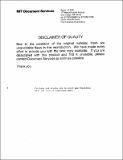Numerical simulations of the effects of microstructure on photonic crystals
Author(s)
Maldovan, Martin.
DownloadFull printable version (3.240Mb)
Other Contributors
Massachusetts Institute of Technology. Dept. of Materials Science and Engineering.
Advisor
W. Craig Carter.
Terms of use
Metadata
Show full item recordAbstract
The optical properties of photonic crystals were studied to gain an understanding of the response of these structures to electromagnetic waves. In particular, multilayer films and two-dimensional systems were studied. It is known that multilayer films present omnidirectional reflectivity for a certain range of frequencies. A numerical technique for solving the Maxwell's equations within infinite periodic structures is presented. The media are assumed to be isotropic, linear, and non-conducting. This technique is based on the Fourier Transform of the dielectric constant of the structure. The numerical formulation allows the determination of the dispersion curves for photonic crystals. From them, omnidirectional reflectivity can be studied. The formulation was used to find the range of forbidden frequencies within an infinite multilayer film composed of two alternating materials. The energy gap for several constitutive parameters is shown. A two-dimensional system composed of infinite rods in a square lattice was also treated with this method. The Matrix Translation Method for studying omnidirectional reflectivity in one-dimensional systems was also used. This method considers homogeneous media and the electromagnetic fields are matched at the interfaces between the media. The formulation is used to obtain the reflectivity of the multilayer film as a function of the direction and frequency of the incident wave. By taking into account all directions and frequencies, omnidirectionality can be found. The method was applied to a finite multilayer film and the results are compared to those obtained with the Fast Fourier Transform Method. Similar results were obtained. An understanding of the properties of photonic crystals was achieved and guidelines for the determination of energy gaps are presented.
Description
Thesis (S.M.)--Massachusetts Institute of Technology, Dept. of Materials Science and Engineering, 2001. Includes bibliographical references (p. 46).
Date issued
2001Department
Massachusetts Institute of Technology. Department of Materials Science and EngineeringPublisher
Massachusetts Institute of Technology
Keywords
Materials Science and Engineering.